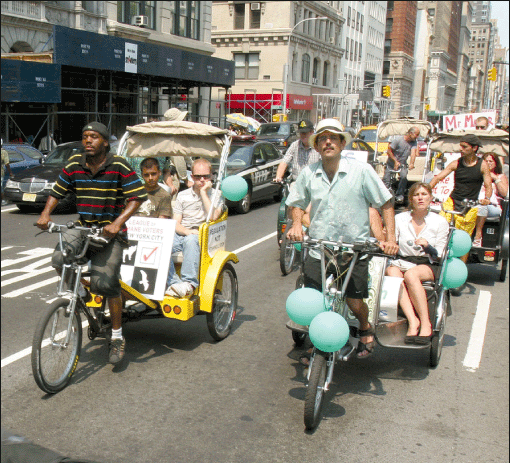By Jefferson Siegel
The city’s 500 pedicab owners and operators are gearing up for the long haul. They’re readying for a protracted battle with the city against a new law that places severe restrictions on their livelihood.
Last Wednesday, several dozen of the pedal-powered cabbies wended their way down traffic-clogged Broadway from Columbus Circle to City Hall to call attention to their plight.
“I’m 30 years old and I’m wearing the same size I was wearing in high school,” said Jesse White as he biked his taxi trike past Chambers St. A driver for three years, White may be in great physical shape but he’s unhappy with the political turn of events. “The demand for pedicabs has risen exponentially,” he said as pedicabbies parked along Broadway and filed into City Hall’s plaza.
After the City Council passed a law capping the number of bicycle taxis, Mayor Bloomberg was lobbied by pedicab drivers who said they would lose their jobs. Bloomberg ultimately vetoed the bill, saying the market should dictate limits. The Council overrode his veto, leaving Public Law 19 scheduled to go into effect on Sept. 20.
“We’re all basically distraught because the nature of the industry is about to change,” said Peter Meitzler, president of the NYC Pedicab Owners Association. Meitzler’s group takes issue with several provisions of the new law, including restricting the transfer of pedicab business licenses, in effect, making a pedicab business worthless should the owner wish to sell.
The law cuts the number of pedicabs by a third, from 500 to 325; bans them from bike lanes and bans their use of an electric-assist motor the size of a hair dryer. Police can also ban the bike taxis’ operation from any area determined to be congested, which covers most of Midtown.
The law also forbids pedicabs from traveling on bridges, meaning operators living in the outer boroughs would face the expense of hiring a truck to transport their wheels into and out of Manhattan.
Doug Korman, co-founder of Green Transporters Association, was wearing a cap with the number 326 on it.
“I’m number 326,” he said as drivers stood behind him on the steps. “Three hundred and twenty-five for a city of 8 million is unfair and un-American.”
Many at the rally criticized Council Speaker Christine Quinn for enabling the law and leading a majority to quash the mayor’s veto. They claim a close friend and neighbor of the speaker, taxi industry lobbyist Emily Giske, was instrumental in urging Quinn to limit the growth of the pedicab industry.
Listening to the speeches but unnoticed by the drivers was Stu Loeser, chief spokesperson for Mayor Michael Bloomberg.
“The mayor made his position on the pedicab bill clear when he vetoed it,” Loeser said.
Others in the Council also took issue with the law. When first proposed, the vote was 37 for the law, 6 against and 2 abstaining. Councilmember Rosie Mendez voted against the bill.
“I had issues with the cap,” Mendez said as she walked into City Hall for a caucus. “We have a vital industry, so all the pedicabs should have been grandfathered in.”
Councilmember Alan Gerson had told the Department of Consumer Affairs, which will grant and regulate licenses, that anyone who filed taxes as a pedicab driver should be given priority for a license. Peter Pastor, Gerson’s legislative director, said the only hope for pedicab drivers now was for a sunset provision in the law. In a year or two, he thought, the cap could then be increased.
Next week, D.C.A. will hold a lottery to distribute pedicab permits.
After the rally, George Bliss, a founder of the New York City pedicab movement, stood by his green pedicab on Broadway. Bliss suggested that as the police, firefighters and sanitation workers are known respectively as New York’s Finest, Bravest and Strongest, the city’s pedicab drivers are New York’s Greenest.
“Politicians can’t keep green transportation from happening,” he declared.



































